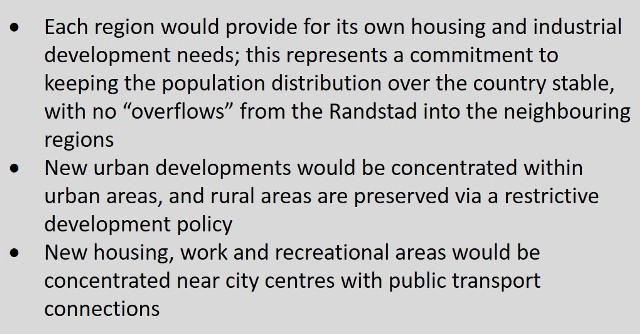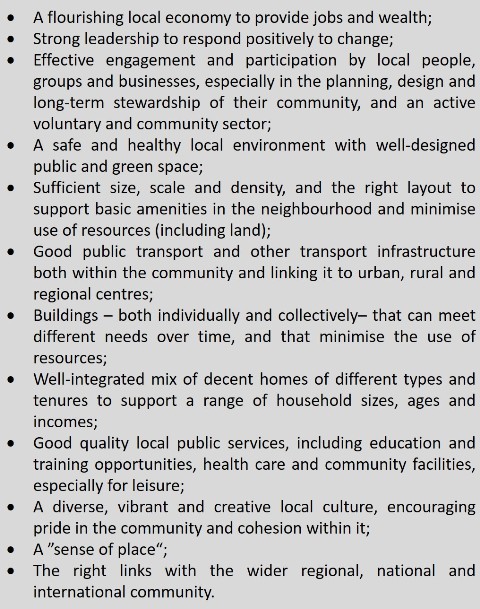
TRANS-URBAN-EU-CHINA
Transition towards urban sustainability through socially integrative cities in the EU and in China
SECTORAL HOUSING PLAN (SHP)
1. Purpose(s)
A Sectoral Housing Plan (SHP) offers a wider framework for the adequate provision of housing for different socio-economic groups in communities. It is widely used in Europe, especially in the Netherlands and in Great Britain. In China, a similar instrument is applied, but mainly for the provision of affordable housing for relatively low-income households. While comprehensive spatial planning, such land use, determines and orients the broad objectives for transforming a territory, sectoral plans, such as SHPs, define strategies and actions for a specific sector, i.e. housing (OECD, 2009). SHPs are usually embedded in more comprehensive strategies and plans dealing with cross-cutting issues, such as inclusion, equity, integration and diversity. However, they focus on the sectorial contribution to achieving related cross-cutting objectives and provide the basis for designing operational plans and mobilizing resources to implement them through action plans (see section on further good practice examples). SHPs can be developed on the base of spatial strategies and plans by the responsible authorities on all levels of government (national, regional, local). SHPs have a strategic function. For instance, they can identify barriers to new housing provision, and develop strategies to more effectively encourage, support and guide urban development in terms of housing provision, affordability and accessibility, design components, services delivery, and connectivity.
IUDP is not limited to “making plans” but also oriented towards implementation. This requires strategic and cooperative urban development management. IUDP develops future visions for development in a collaborative and comprehensive way, and it systematically links respective strategies and guidelines through thematic action programmes reflected in an integrated urban development concepts (IUDC), which allow implementation even under conditions of scarce resources, such as limited time, money, personnel, and land. It provides orientation for medium-term investment and budget planning, as well as specific assistance programmes, i.e. related to social integration in areas with specific needs. Agreements between relevant stakeholders guarantee implementation. Establishing a cross-cutting medium and long-term management system for land, infrastructure and planning ensures timely creation of the required planning regulations and infrastructural pre-conditions for the implementation of projects (Deutscher Städtetag, 2011).
Key Words: sectoral housing plan; housing sector; sectoral planning; housing strategies; housing provision; VIMEX; sustainable communities plan
2. Relevance and Impact
As in socially integrative cities the need for housing evolves and demand for services changes, national, regional and local governments search for housing strategies to accommodate people in the territory in an affordably and environmentally planned way. At the same time, SHP support governments in terms of demographic shifts, assessing how the housing needs will be in the future.
This tool was selected through the analysis of good practices in Europe. It was discussed in international working groups where it was concluded that it is used, but not widely applied in Europe and China.
A SHP provides a framework for the identification of strategies, initiatives and projects related to the housing sector. It defines the role of government or municipal agencies in developing the sector in partnership with other government agencies, the private sector, and other non-government stakeholders. Examples from Europe demonstrate that SHPs can be an effective tool for providing sufficient and adequate housing for all.
3. Strenghts
The SHP provides a detailed statement of housing objectives, performance, needs and opportunities. It contributes to the coordination among public authorities and between the public and private sectors. Thus, it facilitates the sufficient and adequate provision of housing. Through constant monitoring, it also helps to react on changing needs in a flexible way. SHPs are significant to support decision-making on the different levels of government. They allow to design support programmes, to define levels and sources of finance for housing, and to synchronise actions with local financial capacities.
4. Weaknesses
Sectoral planning may conflict with the goals and other requirements laid down in comprehensive planning, such as land-use plans, as both instruments usually address similar areas, and are related to land development and management. Moreover, vertical and horizontal conflicts may hinder the development and implementation of SHPs, i.e., when disputes between the different levels of government regarding priorities and actions arise, and when inter-municipal or public-private dissonances lead to blockades.
5. Good practice examples
VINEX, Netherlands (map)
For decades, the Dutch government has made efforts to steer the development of urban expansion through a series of national spatial plans, focusing, since the 1980s, on compact urban growth (Dieleman and Weneger, 2004). Therefore, national spatial planning, careful urban growth and the wise provision of housing are seen as closely connected issues. In its Fourth Special Report on Spatial Planning (Vierde Nota Ruimtelijke Ordening Extra – VINEX), a policy brief developed by the Ministry of Housing, Spatial Planning and the Environment (VROM) in 1991 for the period 1996-2005, the government strategically designated sites for delivering housing nationally over a long-term. The document strengthened the role of the national government with regard to initiating and implementing large scale urban developments in cooperation with provinces and municipalities (Galle et al., 1997). The National Housing Plan (VINEX 1995-2005) was as a reaction to a housing crisis, proposing a compact urban structure (Box 1) based on the following objectives (OECD, 2001):
- reduce personal mobility by car
- generate a broader social and economic resource base for urban amenities, and thereby creating “vital urban areas”, and
- protecting the remaining open areas
In practice, the plan identified large outer city areas for delivering housing on a national level over the long term, the so called VINEX neighbourhoods. Municipalities were invited to submit schemes of development. The specific sites were chosen by the national government through working groups of national, regional and municipal authorities (Galle et al., 1997). Government helped with seed capital to support soil recovery and access provision, but the schemes had to be self-funding. As a result, ninety schemes and over 450,000 homes were built mainly in new suburbs (61%) increasing the overall housing stock by 7.6% (Falk, 2008b, Clarke et al., 2014). Neighbourhoods included inner-city brownfield sites, urban extensions and semi-independent satellite towns. VINEX promoted “compact urbanisation” (>30 dwellings per hectare) as a means of conserving natural spaces, and linking housing, jobs and services via well-connected public transport, with at least 30% of the housing being affordable (FitzGerald et al., 2019). However, for many critics a target of 30 dwellings per hectare could hardly be called urban (Lörzing, 2006). The figure is equivalent to China’s standard for urban built-up area with 10,000 persons per square kilometre.
The Dutch programme has succeeded in many ways, especially in avoiding sharp price increases in housing market and in facilitating the evolution of socially mixed communities by building more and better homes for all (Falk, 2008a). However, over the years, VINEX received also many criticisms, including its centralised and large scale approach, its implicit contribution to socioeconomic segregation and congestion, and its share in transforming neighbourhoods into “sleeper towns” (Netsch and Kropman, 2011, URBED, 2008). It was replaced in 2006 by the Nota Ruimte, a more decentralised policy. Projects are still nationally coordinated, but decision making is taken at a provincial level encouraging local authorities to bring about small-scale housing developments (Netsch and Kropman, 2011).
Sustainable Communities Plan, Great Britain (map)
The Sustainable Communities Plan was launched by the Office of the Deputy Prime Minister (ODPM) in 2003 to develop housing in both, urban and rural markets. The plan emphasized long-term measures to stabilize communities and remove the need for periodic funding into the same area to address the same problems. It acknowledged the need of different policies with a focus on the problems of growth and affordability, particularly in London and the South East, and on the problem of low demand and decline in the North and Midlands of England. Additionally, the plan aimed to address redeveloping of brownfields and other growth areas in an effort to bring social housing up to decent standards while protecting the countryside from new developments (Sustainable Development Commission, 2007, Power, 2004).
Among other features, the Sustainable Communities Plan focused on a well-integrated mix of decent homes of different types and tenures to support a range of household sizes, ages and incomes, good quality local public services, including education and training opportunities, health care and community facilities, especially for leisure, as well as a diverse, vibrant and creative local culture, encouraging pride in the community and cohesion within it, and a “sense of place” (Box 2).
The action programme addressed a range of partners from private house builders to regional planning bodies. Local governments played a crucial role in tackling low housing demand and abandonment, and in taking growth areas forward (ODPM, 2003). Thus, Local Strategic Partnerships were at the centre of the strategy to promote sustainable communities.
While the responsibility for the programme was shifted from ODPM to the Department for Communities and Local Government (DCLG) in 2006, the Sustainable Communities Plan was revoked in 2015. The programme was seen as an outdated guidance which no longer reflected government policy. It was substituted by a series of policies to get empty buildings back into use.
6. Further helpful study material
Further good practices examples on Sectoral Housing Plans:
- Paris Action Plan for inclusive growth in cities, 2016 (including housing sector): https://www.oecd.org/inclusive-growth/champion-mayors/internationalandregionalevents/Binder2.pdf (retrieved July 3, 2020)
- Homes England Strategic Plan 2018 to 2023: https://www.gov.uk/government/publications/homes-england-strategic-plan-201819-to-202223/homes-england-strategic-plan-2018-to-2023#contents (retrieved July 3, 2020)
- A Guide for Canadian Municipalities for the development of a Housing Action Plan, 2010: https://www.cmhc-schl.gc.ca/en/developing-and-renovating/develop-new-affordable-housing/programs-and-information/guide-canadian-municipalities-for-development-of-housing-action-plan (retrieved July 1, 2020)
- Local Action Plan, City of Regensburg, 2011: https://urbact.eu/sites/default/files/lap_regensburg.pdf (retrieved July 3, 2020)
- Housing Action Plan, Enfield Council, 2019: https://new.enfield.gov.uk/services/planning/housing-action-plan-2019-planning.pdf (retrieved July 3, 2020)
7. References
CLARKE, E., NOHROVÁ, N. & THOMAS, E. 2014. Delivering change:Building homes where we need them. Centreforcities.
DIELEMAN, F. & WENEGER, M. 2004. Compact City and Urban Sprawl. Built Environment, 30 308-323.
FALK, N. 2008a. Making Eco-towns Work: Developing Vathorst, Amerfoort NL. London: Urban and Economic Development Ltd.
FALK, N. 2008b. New Communities - Looking and Learning from Dutch Experience. Town & County Planning, 503-508.
FITZGERALD, C., CAHILL, N. & JORDAN, E. 2019. Transport-Orientated Development:Assessing Opportunity for Ireland. Dublin: National Economic & Social Council,.
GALLE, M., MODDERMAN, E., GALLE, M. M. A. & MODDERMAN, E. J. E. 1997. Vinex: National Spatial Planning Policy in the Netherlands during the nineties. Netherlands journal of housing and the built environment, 12, 9-35.
LÖRZING, H. 2006. Reinventing Suburbia in The Netherlands. Built Environment, 32, 298-310.
NETSCH, S. & KROPMAN, N. 2011. What is Next after VINEX? In: SCHRENK, M., POPOVIC, V. & ZEILE, P. (eds.) REAL CORP 2011. Essen.
ODPM 2003. Sustainable communities:building for the future. London: Office of the Deputy Prime Minister.
OECD 2001. National Peer Review: The Netherlands. In: OECD (ed.) Implementing Sustainable Urban Travel Policies. Paris: OECD.
8. Author(s) of the article
Paulina Schiappacasse, Bernhard Müller

